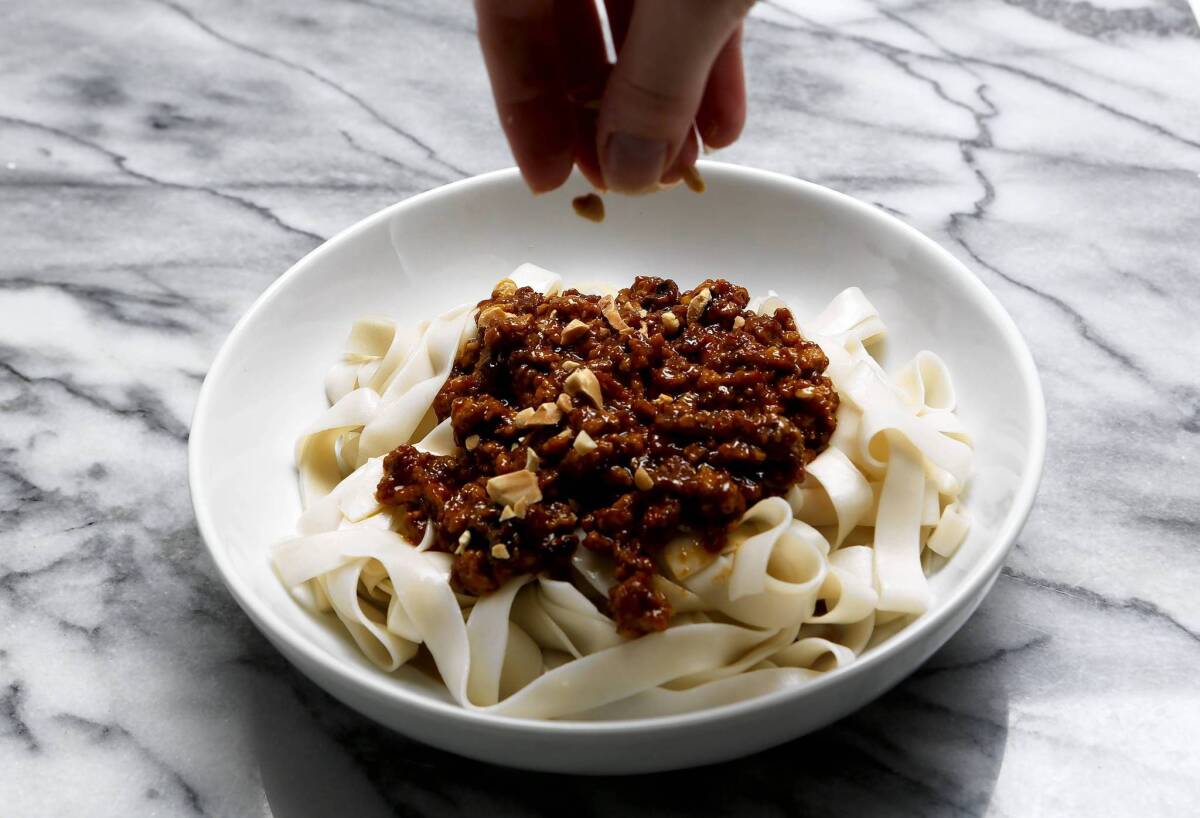Chef Sang Yoon’s ‘numb-hot’ <i>dandan</i> noodle dish emerges from trials by fire

For dandan noodles, a pork mixture is spooned over nooles and the dish is then topped with a sesame sauce and peanuts. Recipe: Dandan noodles
- Share via
Anyone who’s ever worked with me in the kitchen knows that I like to tinker with dishes for a while before I decide to finally offer them on the menu. But then once I’ve gotten them where I want them to be, I tend to let them be. Normally, recipes for my menu items stay consistent and don’t change. However, there’s been one exception. The dandan noodles at my restaurant Lukshon.
Dandan mian is a staple of the Sichuan region of China. It’s also known as peddler’s noodles, the name coming from the wooden pole used to carry noodles and sauce over the shoulders of street vendors. Such humble roots, yet such complex flavor. Each time I’ve tried them, here or overseas, I’ve liked them — even though no two versions have ever seemed to be the same.
Training in French kitchens, I learned that most classic dishes have established “correct” versions. But it seems dandan noodles don’t suffer from such recipe rigidity. Normally they are made with a thin wheat noodle, with a sauce made from sesame and/or peanuts, along with ground pork cooked in doubanjian, a spicy fermented broad bean paste further flavored with Sichuan peppercorns.
But that’s where it stops. There is no normal when it comes to dandan. I’ve had versions with thick noodles and thin noodles. I’ve had versions that were soupy or dry, spicy or sweet, and even a cold version. There’s a Japanese version called tantan mein that is a type of ramen dish.
So a few years ago, when I decided to open Lukshon (which, incidentally, means “noodle” in Yiddish), I wanted to tackle the elusive dandan, a task I found more daunting than I could have imagined. In fact, subconsciously I think I may have opened Lukshon just so I could have a place to tinker with dandan noodles.
I knew I had to start by finding an anchoring principle. For me that is called ma-la, literally “numb-hot” in Mandarin. Ma-la is a core flavor profile of Sichuan cooking and is used to various degrees in countless dishes of the region.
This flavor combination is created by modulating hot dried red chiles and Sichuan peppercorns, an earthy Chinese spice that numbs your tongue. They’re not actually peppercorns but are from the citrus family (in fact, they were banned in the United States for several decades because of fear that they would spread citrus canker to domestic crops; the ban was lifted in 2005).
Ma-la is like a culinary showdown. A heavyweight wrestling match in your mouth. Or if you use too much, it could feel like a battle between your dentist’s drill and Novocain. The idea is to keep these two powerhouses in balance, never letting one overpower the other.
But despite the tension of ma-la, dandan noodles are ultimately a humble dish — a simple, soulful and comforting bowl of noodles. Think spaghetti Bolognese with a lusty kick to the face.
My version starts with a sauce made from ground sesame seeds and peanuts. A soothing sesame and peanut paste cooked with chicken stock or a classic Chinese Shanton broth forms the base of the dish. Unlike many other recipes for dandan, I don’t mix my sesame with other parts of the dish, in essence, deconstructing it a bit.
I then make a Sichuan flavor base that carries all the heat. This second sauce is complex and deeply flavored, containing an array of fermented beans, dry chiles, garlic, ginger, Sichuan peppercorns and black vinegar, and carried in a dry aged Chinese rice wine. It will ultimately combine with the ground pork, becoming the noodle topping.
I also make a shallot-chile jam, a condiment that can be used separately. I add it just to give more depth. The sweetness of the caramelized shallots plays well against the funk of fermented broad beans.
Making this dish is a lot easier than it seems. You don’t have to measure anything exactly. The ingredients may sound exotic, but they’re all widely available in Chinese markets. Make everything a day in advance and just cook noodles, heat the sauces and you’re ready to go.
Should you follow this recipe exactly? Maybe, maybe not. The key to making dandan noodles your own is finding the right balance of heat to numb. So you’ll need to experiment. It’s taken me years to find the right formula, so my recipe is staying put. At least for right now.
More to Read
Eat your way across L.A.
Get our weekly Tasting Notes newsletter for reviews, news and more.
You may occasionally receive promotional content from the Los Angeles Times.






